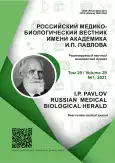A clinical case of successful treatment of complete abruption of the trachea from the larynx
- Authors: Mikheev M.V.1, Trushin S.N.1
-
Affiliations:
- Ryazan State Medical University
- Issue: Vol 29, No 1 (2021)
- Pages: 117-124
- Section: Clinical reports
- URL: https://journal-vniispk.ru/pavlovj/article/view/25899
- DOI: https://doi.org/10.23888/PAVLOVJ2021291117-124
- ID: 25899
Cite item
Abstract
Tracheobronchial injuries as a consequence of chest blunt trauma are rare. Blunt traumas of the cervical part of the trachea are a rarer pathology presenting a serious diagnostic problem for a clinician. Traumas of the larynx and the trachea account for 40 to 80% of lethality. The trachea’s cervical part is vulnerable despite that it is covered with the neck muscles, spine, clavicles, and mandible. In cut/stab wounds, the trachea’s cervical part is often damaged together with the adjacent structures. In blunt trauma, under a direct action of a traumatizing agent, the mobile
trachea displaces toward the spine, accompanied by damage to the tracheal cartilages, its membranous part, and the soft surrounding tissues with preservation of the integrity of the skin.
Tracheal ruptures along the distance up to 1 cm from the cricoid cartilage account for not more than 4% of all tracheal ruptures. A complete tracheal rupture and its abruption from the larynx are extremely rare pathology. Because of severe respiratory disorders, most victims die at the site where their injury occurred.
This article presents a clinical case of the successful treatment of patient Z., 41 years of age, with complete tracheal abruption from the larynx. The cause of tracheal damage was blunt neck trauma in a traffic accident. A peculiarity of this clinical case was that the victim arrived at a specialized thoracic surgery unit with a functioning tracheostomy two days after the trauma.
Conclusion. Tracheal trauma is a potentially fatal condition. Therefore, early diagnosis of tracheobronchial damage is essential since it permits timely surgical intervention and diminished risk of lethal outcome. When dealing with patients with trauma of the head, neck, and chest with non-corresponding clinical data and the absence of effective recommended standard therapeutic measures, a clinician should become alert and exclude the tracheal and bronchial damage.
X-ray computed tomography and fibrotracheobronchoscopy are strongly recommended as reliable methods to diagnose tracheobronchial damages. In a surgical intervention, it is necessary to perform the primary suture on the trachea, avoid preventive tracheostomy, and delay interventions associated with poorer prognosis and a high complication rate.
Full Text
##article.viewOnOriginalSite##About the authors
Mikheev V. Mikheev
Ryazan State Medical University
Author for correspondence.
Email: almiheev77@mail.ru
ORCID iD: 0000-0001-6936-1451
SPIN-code: 7573-0479
ResearcherId: W-8712-2018
MD, PhD, Associate Professor, Associate Professor of the Department of Faculty Surgery with the Course of Anesthesiology and Resuscitation
Russian Federation, Ryazan, RussiaSergey N. Trushin
Ryazan State Medical University
Email: s.trushin@rzgmu.ru
ORCID iD: 0000-0003-0470-6345
SPIN-code: 4679-3870
ResearcherId: X-9102-2018
MD, PhD, Professor, Head of the Department of Faculty Surgery with the Course of Anesthesiology and Resuscitation
Russian Federation, Ryazan, RussiaReferences
- Tulupov AN. Tyazhelaya sochetannaya travma. Saint-Petersburg: Russkiy yuvelir; 2015. (In Russ).
- Parida P-K, Kalaiarasi R, Alexander A. Manage-ment of Laryngotracheal Trauma: A Five-Year Single Institution Experience. Iranian Journal of Otorhinolaryngology. 2018;30(5):283-90.
- Choi JW, Koo BS, Rha KS, et al. Complete Laryngotracheal Separation Following Attempted. Clinical and Experimental Otorhinolaryngology. 2012; 5(3):177-80. doi: 10.3342/ceo.2012.5.3.177
- Johnson SB. Tracheobronchial injury. Seminars in Thoracic and Cardiovascular Surgery. 2008;20(1): 52-7. doi: 10.1053/j.semtcvs.2007.09.001
- Prokakis C, Koletsis EN, Dedeilias P, et al. Airway trauma: a review on epidemiology, mechanisms of injury, diagnosis and treatment. Journal of Cardiothoracic Surgery. 2014;9(1):117. doi:10.1186/ 1749-8090-9-117
- Kiser AC, O'Brien SM, Detterbeck FC. Blunt tracheobronchial injuries: Treatment and outcomes. The Annals of Thoracic Surgery. 2001;71(6):2059-65. doi: 10.1016/s0003-4975(00)02453-x
- Grillo HC. Surgery of the Trachea and Bronchi. London: BC Decker Inc; 2004. P. 693.
- Trunin EM, Mikhaylov AP. Lecheniye raneniy i povrezhdeniy shei. Saint-Petersburg: ELBI-SPb; 2004. (In Russ).
- Sanginov AB, Mosin IV, Mosina NV. Subtotal resection of the trachea by tracheo-brounchial trauma. News of the Academy of Sciences of the Republic Tajikistan. Department of Biological and Medical Sciences. 2009;(2):72-6. (In Russ).
- Bertelsen S, Howitz P. Injuries of the trachea and bronchi. Thorax. 1972;27(2):188-94. doi: 10.1136/thx.27.2.188
- Glinjongol C, Pakdirat B. Management of tracheo-brochial injuries: a 10-year experience at Ratchaburi hospital. Journal of the Medical Association of Thailand. 2005;88(1):32-40.
- Nikitina EM, Sobolewski VA. Reconstruction of the trachea. Overview of the problem. I.P. Pavlov Russian Medical Biological Herald. 2012;(1):127-37. (In Russ).
- Mikheev AV, Rjumin SA. A rare case of foreign body in main bronchus. Nauka Molodykh (Eruditio Juvenium). 2014;(3):96-101. (In Russ).
Supplementary files








